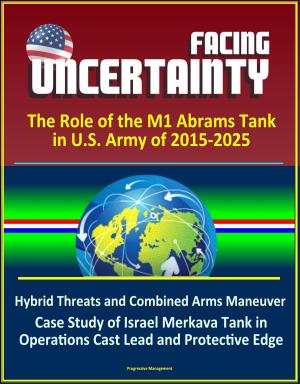Apollo and America's Moon Landing Program: Enchanted Rendezvous, John Houbolt and the Genesis of the Lunar-Orbit Rendezvous Concept and Political and Technical Aspects of Placing a Flag on the Moon
Nonfiction, Science & Nature, Science, Physics, Astronomy, History, Americas| Author: | Progressive Management | ISBN: | 9781465943866 |
| Publisher: | Progressive Management | Publication: | November 26, 2011 |
| Imprint: | Smashwords Edition | Language: | English |
| Author: | Progressive Management |
| ISBN: | 9781465943866 |
| Publisher: | Progressive Management |
| Publication: | November 26, 2011 |
| Imprint: | Smashwords Edition |
| Language: | English |
These official NASA history documents - converted for accurate flowing-text e-book format reproduction - include a Monograph in Aerospace History about the role of John Houbolt and others in advocating the successful Lunar Orbit Rendezvous (LOR) mission concept in the early part of Project Apollo, plus a NASA contractor report on the political and technical aspects of placing the American flag on the lunar surface during the Apollo 11 moonwalk.
Enchanted Rendezvous - John C. Houbolt and the Genesis of the Lunar-Orbit Rendezvous Concept: One of the most critical technical decisions made during the conduct of Project Apollo was the method of flying to the Moon, landing on the surface, and returning to Earth. Within NASA during this debate several modes emerged. The one eventually chosen was lunar-orbit rendezvous (LOR), a proposal to send the entire lunar spacecraft up in one launch. It would head to the Moon, enter into orbit, and dispatch a small lander to the lunar surface. It was the simplest of the various methods, both in terms of development and operational costs, but it was risky. Since rendezvous would take place in lunar, instead of Earth, orbit there was no room for error or the crew could not get home. Moreover, some of the trickiest course corrections and maneuvers had to be done after the spacecraft had been committed to a circumlunar flight. Between the time of NASA's conceptualization of the lunar landing program and the decision in favor of LOR in 1962, a debate raged between advocates of the various methods. John C. Houbolt, an engineer at the Langley Research Center in Hampton, Virginia, was one of the most vocal of those supporting LOR and his campaign in 1961 and 1962 helped to shape in a fundamental way the deliberations. The monograph that is printed here is an important contribution to the study of NASA history in general, and the process of accomplishing a large-scale technological program (in this case Apollo) in particular. In many ways, the lunar mode decision was an example of heterogeneous engineering, a process that recognizes that technological issues are also simultaneously organizational, economic, social, and political. Various interests often clash in the decision-making process as difficult calculations have to be made and decisions taken. What perhaps should be suggested is that a complex web or system of ties between various people, institutions, and interests brought forward the lunar-orbit rendezvous mode of going to the Moon in the 1960s.
Where No Flag Has Gone Before: Political and Technical Aspects of Placing a Flag on the Moon - This paper examines the political and technical aspects of placing a flag on the moon, focusing on the first moon landing. During their historic extravehicular activity (EVA), the Apollo 11 crew planted the flag of the United States on the lunar surface. This flag-raising was strictly a symbolic activity, as the United Nations Treaty on Outer Space precluded any territorial claim. Nevertheless, there were domestic and international debates over the appropriateness of the event. Congress amended the agency's appropriations bill to prevent the National Aeronautics and Space Administration (NASA) from placing flags of other nations, or those of international associations, on the moon during missions funded solely by the United States. Like any activity in space exploration, the Apollo flag-raising also provided NASA engineers with an interesting technical challenge. They designed a flagpole with a horizontal bar allowing the flag to "fly" without the benefit of wind to overcome the effects of the moon's lack of an atmosphere. Other factors considered in the design were weight, heat resistance, and ease of assembly by astronauts whose space suits restricted their range of movement and ability to grasp items.
These official NASA history documents - converted for accurate flowing-text e-book format reproduction - include a Monograph in Aerospace History about the role of John Houbolt and others in advocating the successful Lunar Orbit Rendezvous (LOR) mission concept in the early part of Project Apollo, plus a NASA contractor report on the political and technical aspects of placing the American flag on the lunar surface during the Apollo 11 moonwalk.
Enchanted Rendezvous - John C. Houbolt and the Genesis of the Lunar-Orbit Rendezvous Concept: One of the most critical technical decisions made during the conduct of Project Apollo was the method of flying to the Moon, landing on the surface, and returning to Earth. Within NASA during this debate several modes emerged. The one eventually chosen was lunar-orbit rendezvous (LOR), a proposal to send the entire lunar spacecraft up in one launch. It would head to the Moon, enter into orbit, and dispatch a small lander to the lunar surface. It was the simplest of the various methods, both in terms of development and operational costs, but it was risky. Since rendezvous would take place in lunar, instead of Earth, orbit there was no room for error or the crew could not get home. Moreover, some of the trickiest course corrections and maneuvers had to be done after the spacecraft had been committed to a circumlunar flight. Between the time of NASA's conceptualization of the lunar landing program and the decision in favor of LOR in 1962, a debate raged between advocates of the various methods. John C. Houbolt, an engineer at the Langley Research Center in Hampton, Virginia, was one of the most vocal of those supporting LOR and his campaign in 1961 and 1962 helped to shape in a fundamental way the deliberations. The monograph that is printed here is an important contribution to the study of NASA history in general, and the process of accomplishing a large-scale technological program (in this case Apollo) in particular. In many ways, the lunar mode decision was an example of heterogeneous engineering, a process that recognizes that technological issues are also simultaneously organizational, economic, social, and political. Various interests often clash in the decision-making process as difficult calculations have to be made and decisions taken. What perhaps should be suggested is that a complex web or system of ties between various people, institutions, and interests brought forward the lunar-orbit rendezvous mode of going to the Moon in the 1960s.
Where No Flag Has Gone Before: Political and Technical Aspects of Placing a Flag on the Moon - This paper examines the political and technical aspects of placing a flag on the moon, focusing on the first moon landing. During their historic extravehicular activity (EVA), the Apollo 11 crew planted the flag of the United States on the lunar surface. This flag-raising was strictly a symbolic activity, as the United Nations Treaty on Outer Space precluded any territorial claim. Nevertheless, there were domestic and international debates over the appropriateness of the event. Congress amended the agency's appropriations bill to prevent the National Aeronautics and Space Administration (NASA) from placing flags of other nations, or those of international associations, on the moon during missions funded solely by the United States. Like any activity in space exploration, the Apollo flag-raising also provided NASA engineers with an interesting technical challenge. They designed a flagpole with a horizontal bar allowing the flag to "fly" without the benefit of wind to overcome the effects of the moon's lack of an atmosphere. Other factors considered in the design were weight, heat resistance, and ease of assembly by astronauts whose space suits restricted their range of movement and ability to grasp items.















